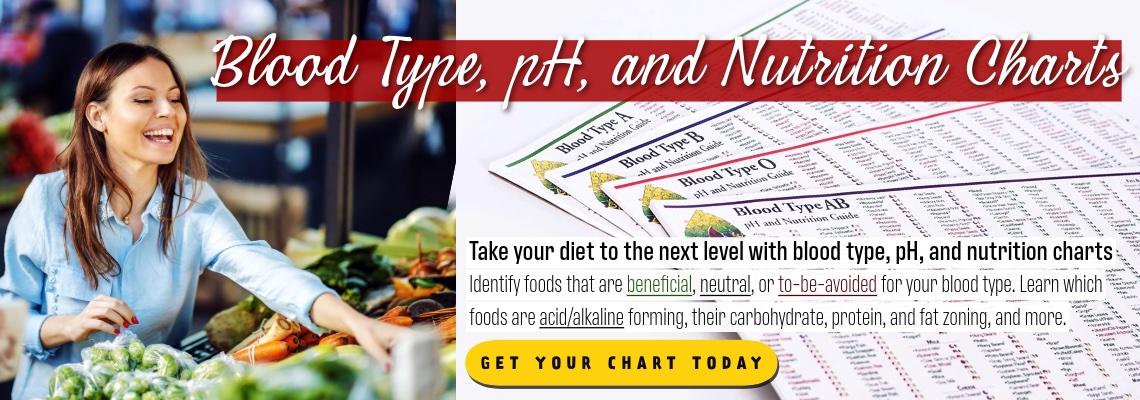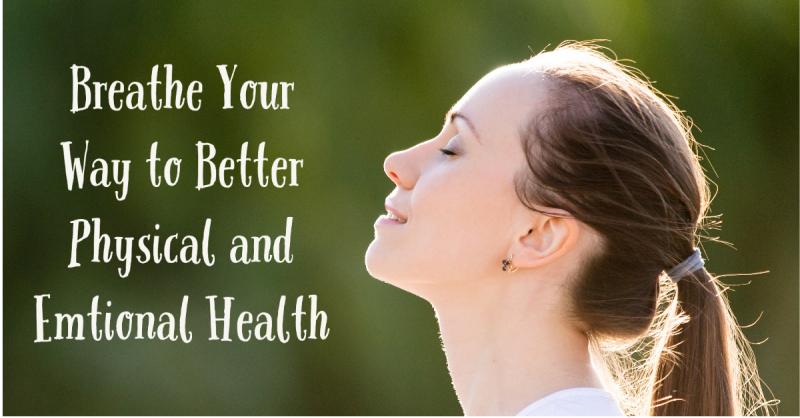
Over the years, I have observed that nearly all chronically ill people are shallow breathers. This is sometimes due to a hiatal hernia, but it can also be a sign of high levels of chronic stress.
Breathing is vital to healing because without proper oxygenation we can’t maintain or even rebuild good health. Breathing is also essential to lymphatic flow, which is part of our immune system and helps our cells detoxify.
Low oxygen levels in the body contribute to depression, fatigue, pain, and increased risk of infection. Cancer cells also thrive in a low-oxygen environment. This is why I teach breathing exercises to chronically-ill people as part of their healing process. After practicing deep breathing exercises, people usually feel more relaxed, energized and alert. Their blood pressure often falls by 10 to 20 points. Many aches and pains also disappear after 10-15 minutes of deep breathing.
Deep breathing exercises are also an essential part of emotional healing work. Shallow breathing disconnects a person from life and feeling. Each basic emotional pattern—fear, joy, excitement, anger, sorrow, pleasure, etc.—has a breathing pattern associated with it. When we block, stuff or otherwise suppress our emotions, we also stifle our breath. By freeing our breath, we learn to let go of these old emotional issues.
Understanding the Breath

The diaphragm is a large muscle that divides the trunk of the body into two halves. The upper half (or chamber) houses the heart and lungs, and the lower half (or chamber) houses the digestive organs (stomach, liver, intestines, etc.). It is a unique muscle because it is under both conscious and unconscious control. Every other muscle is either controlled voluntarily (through the central nervous system) or involuntarily (through the autonomic nervous system). With the diaphragm, we have a choice. We can either allow the diaphragm to remain under involuntary control, or we can consciously alter our breathing.
When we breathe unconsciously, our emotional state is largely controlled by the circumstances of life. What is happening (or not happening) in the world around us unconsciously determines our breathing pattern, and thus, our emotional state. As we take control of our breathing and learn to breathe consciously, we also learn to consciously choose the emotional frequency at which we vibrate. This allows us to gain control of our lives as well as our health.
The natural way to breathe is to inhale by contracting the diaphragm downward toward the pelvis, as illustrated in the figure below right. This causes the lower part of the body (the belly) to expand outward. As we exhale, the diaphragm moves upwards towards the head, which is also illustrated in the figure below right. If you watch a baby breathing, you will see his or her belly gently rising and falling. This is the natural way to breathe.
Most adults can no longer breathe in this manner. They breathe by lifting their chest. These muscles weren’t designed to continually inflate and deflate the lungs, so they fatigue when called upon to do so. It is also impossible to properly inflate the lungs by using the chest muscles, so tissues are chronically deprived of oxygen—the most important “nutrient” the body needs for good health.
Chest breathing also makes us “top heavy” so that the stresses of life push us around more. Breathing from the diaphragm, on the other hand, makes us feel more centered and calmer during stressful times. When we breathe downward into our “guts” we are more stable and harder to push around.
When the diaphragm is able to move up and down properly there is an added benefit. The movement of the diaphragm “massages” the internal organs, improving lymphatic flow and helping to keep these tissues healthy.
Are You a Shallow Breather?

To determine if you are a chronically shallow breather, lay on your back and relax. Place one hand on your abdomen (over your belly button) and the other hand on your chest (over your heart). Now take a deep breath. If you are breathing properly, the hand on you belly should rise, but the hand on your chest should rise very little. If the hand on your chest rises and the hand on your belly moves in slightly or doesn’t move at all, you’re breathing shallowly. If you are a shallow breather, the following deep breathing exercise will help to retrain your muscles.
Deep Breathing Exercise
In the beginning, it's easier to practice deep, conscious breathing while lying on your back. It is best to lie flat on the floor or bed with no pillow under your head. However, if not having a pillow causes you pain, go ahead and use one because it's important that you feel comfortable and relaxed. Place a pillow under your knees as well. If you have problems with your lower back, lie down with your calves resting on a couch or chair.
Inhale deeply while lifting your stomach. Exhale, sucking your stomach in and pushing as much air out of your lungs as possible. Start by inhaling for the count of four, pausing for a moment, and then exhaling for the count of four. You can say to yourself as you inhale, “in-two-three-four” and as you exhale, “out-two-three-four.” Practice this type of deep breathing daily for 10-15 minutes. If you are completely unable to do this, you may have a hiatal hernia. There is an article (and video) on this website to help you learn how to correct a hiatal hernia. You can also do an abdominal massage in the area just below your rib cage to try to relax this area and get your diaphragm moving properly again.
As you strengthen the diaphragm by exercising it in this manner, you can start increasing the length of inhalation and exhalation. Try to increase both the inhalation and the exhalation to a count of five, then six and so forth. With enough practice a person can actually increase the depth of their breathing until they reach a count of 20 or even 30. As the diaphragm gets exercised in this manner, deep breathing becomes more and more automatic, resulting in richer oxygen levels in the blood and better health.
Breathing and Emotions
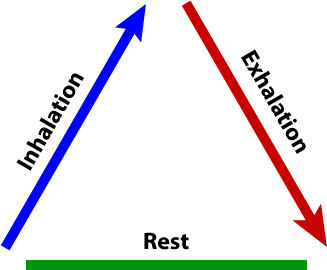 In the early 1990s, I had a dream about energy and one of the things I learned in my dream was that all emotions have breathing patterns. Since that time I have observed this to be the case and can readily evoke a variety of emotions within myself simply by altering my breathing pattern. Here are the basics of what I’ve learned about breathing, energy, and emotions. The normal breathing pattern has three parts. We inhale, exhale and then pause before taking another breath. These three parts of breathing represent the three basic parts of an energy wave—expansion, contraction, and equilibrium. Expansion is “yin” energy. Yin draws in and is the force of attraction. It pulls or draws the breath (and energy) into the body. Contraction is the “yang” energy. Yang expels and is the force of expulsion or discharge. The third force at work here is equilibrium or rest, when there is a moment of stability before the cycle starts again.
In the early 1990s, I had a dream about energy and one of the things I learned in my dream was that all emotions have breathing patterns. Since that time I have observed this to be the case and can readily evoke a variety of emotions within myself simply by altering my breathing pattern. Here are the basics of what I’ve learned about breathing, energy, and emotions. The normal breathing pattern has three parts. We inhale, exhale and then pause before taking another breath. These three parts of breathing represent the three basic parts of an energy wave—expansion, contraction, and equilibrium. Expansion is “yin” energy. Yin draws in and is the force of attraction. It pulls or draws the breath (and energy) into the body. Contraction is the “yang” energy. Yang expels and is the force of expulsion or discharge. The third force at work here is equilibrium or rest, when there is a moment of stability before the cycle starts again.
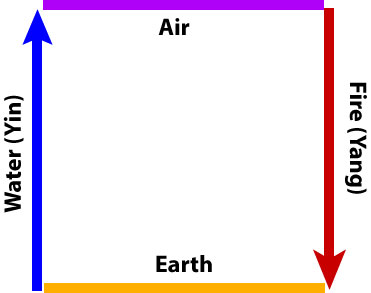 There is a fourth part of the energy cycle which we don’t see as readily in the breath, but it is there. It is the pause at the top of the breath after the lungs have inflated. This represents the force opposite of rest or equilibrium, which is disequilibrium or change. It is the transition from expansion to contraction, from “filling up” to “emptying out.” These four parts of the breathing cycle correspond to the four-element energetics. Water is the yin force of expansion. It makes plants grow; it dissolves or absorbs things. Fire is the yang force of contraction. It breaks things apart and discharges them. Earth is the stable force that represents rest and stability, while air is volatile and changing. It is from this insight that my understanding of the following breathing patterns emerged.
There is a fourth part of the energy cycle which we don’t see as readily in the breath, but it is there. It is the pause at the top of the breath after the lungs have inflated. This represents the force opposite of rest or equilibrium, which is disequilibrium or change. It is the transition from expansion to contraction, from “filling up” to “emptying out.” These four parts of the breathing cycle correspond to the four-element energetics. Water is the yin force of expansion. It makes plants grow; it dissolves or absorbs things. Fire is the yang force of contraction. It breaks things apart and discharges them. Earth is the stable force that represents rest and stability, while air is volatile and changing. It is from this insight that my understanding of the following breathing patterns emerged.
Anger
 Anger is a “yang” emotion and the body’s breathing and movement pattern shows that it is designed to push away things that would harm us. Anger, in a sense, is a detoxifying emotion. The breathing pattern for anger begins with a slow inhalation building up a very high energy charge in the body. This is followed by a rapid, forced exhalation, which can come out as yelling, shouting, screaming or other patterns of loud, forced vocalization. This is accompanied by the arms pushing away or punching outward, which shows that anger is trying to expel or push things away.
Anger is a “yang” emotion and the body’s breathing and movement pattern shows that it is designed to push away things that would harm us. Anger, in a sense, is a detoxifying emotion. The breathing pattern for anger begins with a slow inhalation building up a very high energy charge in the body. This is followed by a rapid, forced exhalation, which can come out as yelling, shouting, screaming or other patterns of loud, forced vocalization. This is accompanied by the arms pushing away or punching outward, which shows that anger is trying to expel or push things away.
Grief
 Grief is a “yin” emotion and there is a specific breathing pattern for it that is very different than that of anger. In grief, the inhalation is forced and difficult. The person may gasp for air or struggle to breathe in. Exhalation, on the other hand, is long, slow, and often accompanied by sighing, wailing, moaning, groaning or weeping. In grief, the person has suffered a loss and is struggling to feel the emptiness they are experiencing. They are also “letting go of” or releasing what was lost.
Grief is a “yin” emotion and there is a specific breathing pattern for it that is very different than that of anger. In grief, the inhalation is forced and difficult. The person may gasp for air or struggle to breathe in. Exhalation, on the other hand, is long, slow, and often accompanied by sighing, wailing, moaning, groaning or weeping. In grief, the person has suffered a loss and is struggling to feel the emptiness they are experiencing. They are also “letting go of” or releasing what was lost.
Depression
 The more depressed a person is, the more shallow their breathing. This is an expression of the low level of vitality in someone who is suffering from depression. Both the inhalation and exhalation are short and shallow. The pause in between the breaths is also longer. Energetically, a depressed person can neither let go of things nor take things in. They are stuck outside the normal flow of life energy.
The more depressed a person is, the more shallow their breathing. This is an expression of the low level of vitality in someone who is suffering from depression. Both the inhalation and exhalation are short and shallow. The pause in between the breaths is also longer. Energetically, a depressed person can neither let go of things nor take things in. They are stuck outside the normal flow of life energy.
Awed or Inspired
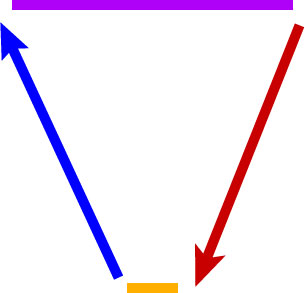 The opposite emotional state of depression is feeling awed or inspired. The very word “inspired” is linked to the breath, as to in-spire is to breathe in. Inspiration, therefore, is a state of being filled with the “breath of life” or the element of air. This is one of the only breathing patterns where the fourth part of the breathing cycle is very noticeable. When something “takes our breath away” we draw in air and hold it there. We then slowly release it. It’s almost as if we’re trying to draw in something amazing and beautiful and never let go of it. This breathing pattern can also involve very short pauses at the “bottom” of the breath. We are not stable or in equilibrium when we are inspired; we are in a state of disequilibrium and engaged in a process of being changed or transformed by something.
The opposite emotional state of depression is feeling awed or inspired. The very word “inspired” is linked to the breath, as to in-spire is to breathe in. Inspiration, therefore, is a state of being filled with the “breath of life” or the element of air. This is one of the only breathing patterns where the fourth part of the breathing cycle is very noticeable. When something “takes our breath away” we draw in air and hold it there. We then slowly release it. It’s almost as if we’re trying to draw in something amazing and beautiful and never let go of it. This breathing pattern can also involve very short pauses at the “bottom” of the breath. We are not stable or in equilibrium when we are inspired; we are in a state of disequilibrium and engaged in a process of being changed or transformed by something.
Excitement and Anxiety
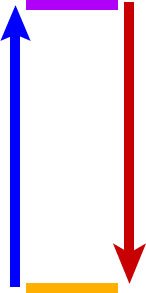 Both excitement and anxiety are similar emotional states, as they both involve a level of fear. When a person feels that the scary experience is manageable they experience this state as excitement. When they feel that it is unmanageable, or the source of the fear is repressed and not understood in conscious awareness, the emotion is experienced as anxiety. Both inhalation and exhalation are rapid, with very short pauses between breaths. This lack of a pause at the bottom of the breath shows a lack of feeling grounded, stable or secure. There can also be a slight holding of one's breath after inhalation as the person becomes somewhat “spacy” or air-headed.
Both excitement and anxiety are similar emotional states, as they both involve a level of fear. When a person feels that the scary experience is manageable they experience this state as excitement. When they feel that it is unmanageable, or the source of the fear is repressed and not understood in conscious awareness, the emotion is experienced as anxiety. Both inhalation and exhalation are rapid, with very short pauses between breaths. This lack of a pause at the bottom of the breath shows a lack of feeling grounded, stable or secure. There can also be a slight holding of one's breath after inhalation as the person becomes somewhat “spacy” or air-headed.
Squaring Your Breath
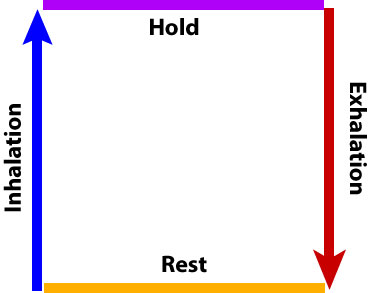 When you make all four parts of the breath cycle equal in length you center yourself. It helps draw you into a place of peace and emotional neutrality, where you can observe your body and feelings objectively. To square your breath, lie down or sit up straight. Relax and start to breathe deeply. Be sure to inhale while lifting the stomach and exhale as the stomach moves backward. Now start counting your breath as we discussed in the first breathing exercise. Only this time inhale for the count of four, hold for the count of four, exhale for the count of four and then hold again for a count of four. You can say to yourself as you inhale, “in-two-three-four,” then as your lungs are full “hold-two-three-four,” then exhale, “out-two-three-four” and as your lungs are empty, “hold-two-three-four.” This is a great breathing pattern for moving a person into a calm, relaxed and meditative state.
When you make all four parts of the breath cycle equal in length you center yourself. It helps draw you into a place of peace and emotional neutrality, where you can observe your body and feelings objectively. To square your breath, lie down or sit up straight. Relax and start to breathe deeply. Be sure to inhale while lifting the stomach and exhale as the stomach moves backward. Now start counting your breath as we discussed in the first breathing exercise. Only this time inhale for the count of four, hold for the count of four, exhale for the count of four and then hold again for a count of four. You can say to yourself as you inhale, “in-two-three-four,” then as your lungs are full “hold-two-three-four,” then exhale, “out-two-three-four” and as your lungs are empty, “hold-two-three-four.” This is a great breathing pattern for moving a person into a calm, relaxed and meditative state.
Unresolved Emotional Stress
 As I’ve already indicated, unresolved emotional stress inhibits breathing. Imagine that you’ve just been punched in the stomach and had the “wind knocked out of you.” Pain creates contraction. The blow causes your midsection to contract, which stifles movement in the diaphragm. The body contracts around the pain to protect the damaged area. Holding your breath reduces oxygenation to tissues, which temporarily “numbs” the body to feeling.
As I’ve already indicated, unresolved emotional stress inhibits breathing. Imagine that you’ve just been punched in the stomach and had the “wind knocked out of you.” Pain creates contraction. The blow causes your midsection to contract, which stifles movement in the diaphragm. The body contracts around the pain to protect the damaged area. Holding your breath reduces oxygenation to tissues, which temporarily “numbs” the body to feeling.
But physical pain isn’t the only thing that can make us contract and hold our breath. Emotional pain does the same thing. Think of what happens when we’re afraid or grieving. We contract around the diaphragm and hold our breath. The act of expressing those feelings through sobbing, trembling or shouting helps to release this contraction and restore normal balance or tone.
When emotions are not released, our body remains contracted and our breathing remains shallow. People wonder why they can’t get past the pain they feel inside, and it’s because they’ve contracted their body and stifled their breathing to inhibit its release. As you relax and breathe deeply, these feelings may come up. If you breathe with them, they will easily flow out of your body and be gone forever.
Feeling an emotion won’t hurt you, because allowing an emotion to simply "be" allows it to be released. Trying to make it go away takes us out of the flow of life and causes it to become stuck within us. There is an irony here; in trying to avoid or get rid of unpleasant emotions we actually wind up perpetuating them.
Letting Go
 Exhalation is the most important part of breathing when trying to release trauma, pain, and stress from past experiences. That’s because exhaling is “letting go.” If you learn to empty your lungs, you can learn to release the burden of emotional “baggage” from the past.
Exhalation is the most important part of breathing when trying to release trauma, pain, and stress from past experiences. That’s because exhaling is “letting go.” If you learn to empty your lungs, you can learn to release the burden of emotional “baggage” from the past.
To help you let go, try the following breathing exercise. Sit up straight or lay on your back. Inhale deeply through the nose. Be sure to breathe into your belly, moving your diaphragm downwards. Hold your breath for just a second. Now, exhale as deeply as you can, either through your mouth or your nose. Try to push as much air out of your lungs as you possibly can. Suck in your stomach hard, pushing and pushing to get as much air out of your lungs as possible.
When you breathe in again, you will feel how forcibly exhaling and letting go created space for your lungs to fill up even more deeply with fresh air. This is a metaphor for life. Nature abhors a vacuum. Holding onto the past means there is no room for the new. Releasing the past opens space for the new to enter.
Breathing and Awareness
Our final breathing exercise helps take you into a deep state of awareness or inner stillness. This isn’t just allowing your lungs to empty out, it’s allowing your mind to “empty out” and become still. Most of us have minds that are constantly “chattering.” This chattering consists of running thoughts mostly programmed into our minds by others. By learning to quiet the mind, you create “space” where you can receive inspiration, guidance and help in solving your problems and creating a better life. Learning to quiet the mind is the goal of meditation. I look at meditation as a complement to prayer. Prayer is you talking to God, while meditation is learning to listen to the “still, small voice” of the Spirit.
To do this breathing exercise, you can either sit comfortably or lie down. Again, start breathing slowly and deeply. Count each breath if you like. Allow your body to relax as completely as possible. One way of doing this is to tense each part of the body and then relax it, starting at your feet and moving to your head.
When you are relaxed and breathing slowly and deeply, focus intently on your breathing. Just pay attention to the breath and nothing else. If thoughts arise in your mind, don’t “fight” them, just refocus your mind on your breath. With practice you will be able to focus your mind so intensely that there are no words flowing through your brain.
When you are able to do this, practice focusing on the rest of your body in the same way. Notice all the sensations of the body (both physical and emotional feelings). Don’t start making verbal commentary on what you are experiencing, just experience it. Again, with practice you’ll be able to experience your body and your emotions without trying to translate the experience into words.
The final step in this exercise (which may take several months of daily practice to get to) is to be able to focus on things outside yourself with the same intensity. For instance, to look at a tree or flower, or even listen to another person, without making mental verbal commentary. Your entire focus is on absorbing the experience.
This is a great place to arrive at because it allows you to see and hear so much more than the average person does. It expands your awareness—of yourself and others. It also teaches you that you can control the “dialog” going on in your head and shift it towards things you want and choose to think about, rather than whatever random thoughts pop into your head.
Breathing is a wonderful tool for healing, both physically and emotionally. To be able to breathe fully and deeply is to be intensely alive and free at the same time. Start practicing these breathing exercises and they will make a dramatic difference in your well-being as they have in mine.
Steven's Articles
-

-
The Sensible Use of Caffeinated Herbs
Kola nuts, guarana, and yerba mate and other herbs…
-

-
The Health Benefits and Problems with Coffee
This popular caffeinated beverage can be beneficial…
October
-

-
Understanding Caffeine & Cellular Adaptation
Preserving the power of caffeine's buzz and the…
September
-

-
Horseradish
A pungent spice for aiding protein metabolism…
-

-
Banaba or Crepe Myrtle
A beautiful tree from Southeast Asia whose leaves…
August
-

-
Monkeyflowers
Flower essences to help see ourselves more clearly…
-

-
Mariposa Lilies
Strengthening the bond between mother and child…
-

-
The Noble Bay Leaf
A common kitchen herb for aiding digestion and…
-

-
Epimedium: Horny Goat Weed
A circulatory stimulant and kidney yang tonic…
July
-

-
The Medicinal and Nutritional Benefits of Apricots
A nutritious fruit and valuable medicinal seed for coughs
-

-
Dogwoods
Asian dogwood is used to stop excessive discharge,…
June
-

-
Neem: The Village Pharmacy
A popular Ayurvedic remedy for dental and immune…
-

-
Spilanthes: The Toothache Plant
A traditional remedy for teeth and gums, as well…
-

-
Forsythia
An anti-inflammatory, fever-reducing, and infection fighting herb
May
-

-
Buckwheat (Kashi)
A delicious, high protein, gluten-free, gut-healthy food

